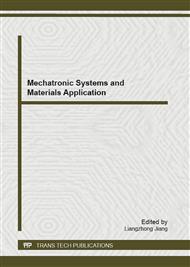[1]
Hu S.J., Stream of Variation Theory for Automotive Body Assembly, Annals Of The Cirp, 1997, Vol. 46/1, pl-6.
DOI: 10.1016/s0007-8506(07)60763-x
Google Scholar
[2]
Liu S. Charles, Hu S. Jack, An Offset Finite Element Model and Its Applications in Predicting Sheet Metal Assembly Variation, International Journal of Machine Tools and Manufacturing, 1995, Vol. 35, No. 11, pp.1545-1557.
DOI: 10.1016/0890-6955(94)00103-q
Google Scholar
[3]
Liu S. Charles, Hu S. Jack, Variation Simulation for deformable Sheet Metal Assemblies Using Finite Element Methods, Journal of Manufacturing Science and Engineering, 1997, Vol. 119, pp.368-374.
DOI: 10.1115/1.2831115
Google Scholar
[4]
Cai W, Hu S.J. and Yuan J. X: Deformable Sheet Metal Fixturing: Principles, Algorithms, and Simulations, Journal of Manufacturing Science and Engineering, 1999, Vol. 121, pp.771-777.
DOI: 10.1115/1.2831031
Google Scholar
[5]
Liu S. Charles, Hu S. Jack, Sheet Metal Joint Configurations and Their Variation Characteristics, Journal of Manufacturing Science and Engineering, 1998, Vol. 120, pp.461-467.
DOI: 10.1115/1.2830147
Google Scholar
[6]
Mantripragada Ramakrishna, Whitney Daniel E. Modeling and Controlling Variation Propagation in Mechanical Assemblies Using State Transition Models, IEEE Transactions On Robotics and Automation, 1999, Vol. 15, No. 1, pp.124-140.
DOI: 10.1109/70.744608
Google Scholar
[7]
Srinivasan Vijay, On Interpreting Key Characteristics, Proceedings of the 1999 ASME Design Engineering Technical Conferences, September 12-15, 1999, Las Vegas, Nevada.
Google Scholar
[8]
Lee Don J., Thornton Anna C, The Identification and Use of Key Characteristics In the Product Development Process, Proceedings of the 1996 ASME Design Engineering Technical Conferences and Computers in Engineering Conference, August 18-22, 1996, Irvine, California.
Google Scholar
[9]
Thornton Anna C., Mathematical Framework for the Key Characteristic Process, Research in Engineering Design-Theory, Applications, and Concurrent Engineering, 1999, Vol. 11, No. 3, pp.145-157.
DOI: 10.1007/s001630050011
Google Scholar
[10]
Thornton Anna C., Variation Risk Management Using Modeling and Sinulation, Journal of Mechanical Design, 1999, Vol. 121, pp.297-303.
Google Scholar
[11]
Thornton Anna C., Quantitative Selection of Variation Reduction Plans, Journal of Mechanical Design, 2000, Vol. 122, pp.185-193.
DOI: 10.1115/1.533559
Google Scholar
[12]
Chase K.W., Magleby S.P., Glancy C.G., A Comprehensive System for Computer-Aided Tolerance Analysis of 2-D and 3-D Mechanical Assemblies, Proceedings of the 5th CIRP Seminar on Computer-Aided Tolerancing, Toronto, Ontario, April 28-29, (1997).
DOI: 10.1007/978-1-4615-5797-5_23
Google Scholar
[13]
Chase K.W., Parkinson A.R., A survey of research in the application of tolerance analysis to the design of mechanical assemblies, Research in Engineering Design, 1991, Vol. 3, pp.23-37.
DOI: 10.1007/bf01580066
Google Scholar
[14]
Chase K.W., Gao J., Magleby S.P., General 2-D tolerance analysis of mechanical assemblies with small kinematic adjustments, Journal of Design and Manufacturing, 1995, Vol. 5, pp.263-274.
Google Scholar
[15]
Chase K.W., Greenwood W.H., Loosli B.G., Hauglund L.F., Least cost tolerance allocation for mechanical assemblies with automated process selection, American Society of Mechanical Engineers, Design Engineering Division(Publication)DE, 1989, Vol. 16, pp.165-171.
Google Scholar
[16]
Gao Jinsong, Chase Kenneth W., Magleby Spencer P., Generalized 3-D tolerance analysis of mechanical assemblies with small kinematic adjustments, IIE Transactions(Institute of Industrial Engineers), 1998, Vol. 30, No. 4, pp.367-377.
DOI: 10.1080/07408179808966476
Google Scholar
[17]
Gao Jinsong, Chase Kenneth W., Magleby Spencer P., Comparison of assembly tolerance analysis by Direct Linearization and modified Monte Carlo simulation methods, American Society of Mechanical Engineers, Design Engineering Division(Publication)DE, 1995, Vol. 82, No. 1, pp.353-360.
DOI: 10.1115/detc1995-0047
Google Scholar
[18]
Chase Kenneth W., Gao Jinsong, Magleby Spencer P., Sorensen Carl D., Including geometric feature variations in tolerance analysis of mechanical assemblies, IIE Transactions(Institute of Industrial Engineers), 1996, Vol. 28, No. 10, pp.795-807.
DOI: 10.1080/15458830.1996.11770732
Google Scholar
[19]
Merkley Karl, Chase ken, Breaking down tolerance stack-up, Machine Design, 1997, Vol. 69, No. 8, pp.71-74.
Google Scholar
[20]
Merkley Karl, Tolerance Analysis of Compliant Assemblies, [Dissertation], Provo, Utah, USA, Brigham Young University, (1998).
Google Scholar
[21]
Jeffreys D. Leaney P.G., Dimensional control as an integral part of next-generation aircraft development, Proc Instn Mech Engrs., Part B, 2000, Vol. 214, No. 9, pp.831-835.
DOI: 10.1243/0954405001517900
Google Scholar
[22]
Johannesson Hans, Soderberg Rikard, Structure and matrix models for tolerance analysis from configuration to detail design, Research in Engineering Design-Theory, Applications, and Concurrent Engineering, 2000, Vol. 12, No. 2, pp.112-125.
DOI: 10.1007/s001630050027
Google Scholar
[23]
LiDeyi,DuYi. Uncertanty Artificial Intelligence[M]. BeiJing:National Defence Industry Press, (2005).
Google Scholar


